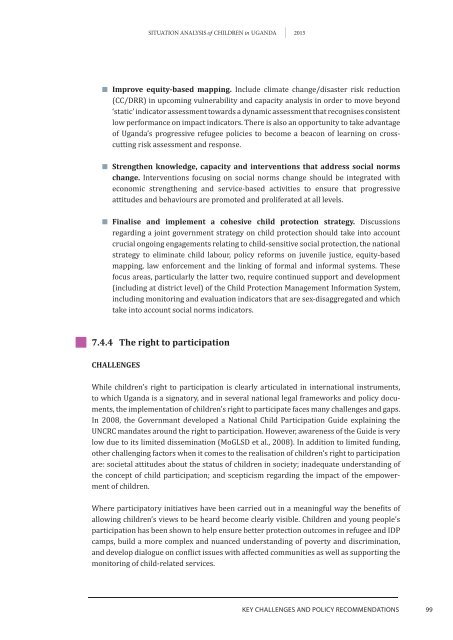Situation analySiS
1TNu802
1TNu802
Create successful ePaper yourself
Turn your PDF publications into a flip-book with our unique Google optimized e-Paper software.
<strong>Situation</strong> <strong>analySiS</strong> of Children in uganda 2015Improve equity-based mapping. Include climate change/disaster risk reduction(CC/DRR) in upcoming vulnerability and capacity analysis in order to move beyond‘static’ indicator assessment towards a dynamic assessment that recognises consistentlow performance on impact indicators. There is also an opportunity to take advantageof Uganda’s progressive refugee policies to become a beacon of learning on crosscuttingrisk assessment and response.Strengthen knowledge, capacity and interventions that address social normschange. Interventions focusing on social norms change should be integrated witheconomic strengthening and service-based activities to ensure that progressiveattitudes and behaviours are promoted and proliferated at all levels.Finalise and implement a cohesive child protection strategy. Discussionsregarding a joint government strategy on child protection should take into accountcrucial ongoing engagements relating to child-sensitive social protection, the nationalstrategy to eliminate child labour, policy reforms on juvenile justice, equity-basedmapping, law enforcement and the linking of formal and informal systems. Thesefocus areas, particularly the latter two, require continued support and development(including at district level) of the Child Protection Management Information System,including monitoring and evaluation indicators that are sex-disaggregated and whichtake into account social norms indicators.7.4.4 The right to participationCHALLENGESWhile children’s right to participation is clearly articulated in international instruments,to which Uganda is a signatory, and in several national legal frameworks and policy documents,the implementation of children’s right to participate faces many challenges and gaps.In 2008, the Governmant developed a National Child Participation Guide explaining theUNCRC mandates around the right to participation. However, awareness of the Guide is verylow due to its limited dissemination (MoGLSD et al., 2008). In addition to limited funding,other challenging factors when it comes to the realisation of children’s right to participationare: societal attitudes about the status of children in society; inadequate understanding ofthe concept of child participation; and scepticism regarding the impact of the empowermentof children.Where participatory initiatives have been carried out in a meaningful way the benefits ofallowing children’s views to be heard become clearly visible. Children and young people’sparticipation has been shown to help ensure better protection outcomes in refugee and IDPcamps, build a more complex and nuanced understanding of poverty and discrimination,and develop dialogue on conflict issues with affected communities as well as supporting themonitoring of child-related services.KEy ChaLLENGES aND PoLICy rECoMMENDatIoNS99




